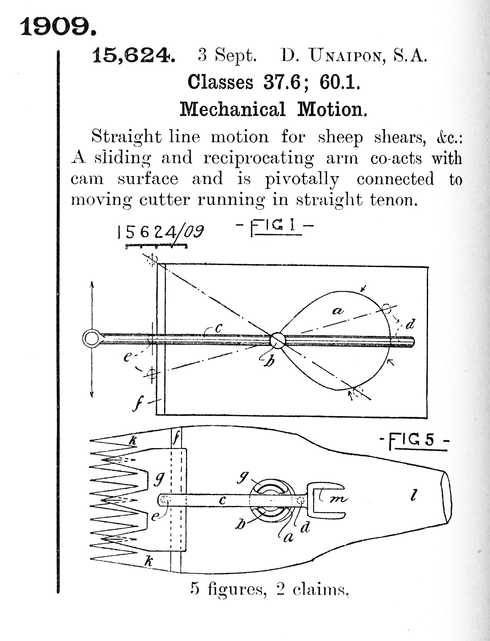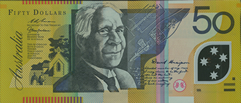David Unaipon – inventor
 David
Unaipon was born at Point McLeay Mission on 28 Sep 1872,
the son of the evangelist, James Ngunaitponi, and Nymbulda.
David showed an early interest in education which resulted
in him acquiring many skills including the talent for public
speaking which he used to advantage to promote his message
that Aboriginal people should be allowed to join the mainstream
of society rather than be locked up on reserves. His prominence
in public life as a spokesman for Aboriginal people led
to him being called upon to participate in royal commissions
and inquiries into Aboriginal issues. In 1928–29 he
assisted the Bleakley inquiry into Aboriginal welfare. In
1934, he urged the Commonwealth to assume responsibility
for Aboriginal affairs. Within South Australia he proposed
that an independent board replace Chief Protector of Aborigines. David
Unaipon was born at Point McLeay Mission on 28 Sep 1872,
the son of the evangelist, James Ngunaitponi, and Nymbulda.
David showed an early interest in education which resulted
in him acquiring many skills including the talent for public
speaking which he used to advantage to promote his message
that Aboriginal people should be allowed to join the mainstream
of society rather than be locked up on reserves. His prominence
in public life as a spokesman for Aboriginal people led
to him being called upon to participate in royal commissions
and inquiries into Aboriginal issues. In 1928–29 he
assisted the Bleakley inquiry into Aboriginal welfare. In
1934, he urged the Commonwealth to assume responsibility
for Aboriginal affairs. Within South Australia he proposed
that an independent board replace Chief Protector of Aborigines.
Apart from his social messages, David was absorbed by the
concept of perpetual motion. He spent much effort designing
machines which led to the media dubbing him the black
Leonardo. In 1909 he patented an improved handpiece
for sheep-shearing (pictured: Patent specification. Mechanical
motion. Sheep shears. No. 15,624, 1909. D. Unaipon, SA as depicted in Aust Patent Office: Australian Official Journal of Patents, Govt Printer Melbourne 1910, p910).
His other inventions included a centrifugal motor, a multi-radial
wheel and mechanical propulsion device. He never succeeded
in getting any financial support to develop his ideas. As
early as 1914, Unaipon had anticipated the concept of a
helicopter by applying the principle of the boomerang.
David became the first Aboriginal writer to be published.
In the 1920s he was commissioned by the University of Adelaide
to collect traditional Aboriginal stories from around South
Australia. Most of the stories come from his own Ngarrindjeri
people, but some are from other South Australian peoples.
 These
were compiled into the publication, Myths and Legends
of the Australian Aboriginals London, 1930 which failed
to attribute his authorship. His most known books are Aboriginal
Legends (1927), Native Legends (1929) and
Leaves of memory (1953). He also wrote his autobiography
called, My Life Story in 1951. Other articles,
poetry and legends were published throughout his life. His
work on legends is reflected in the art work that
accompanies his image on the 1992 $50 Australian banknote. These
were compiled into the publication, Myths and Legends
of the Australian Aboriginals London, 1930 which failed
to attribute his authorship. His most known books are Aboriginal
Legends (1927), Native Legends (1929) and
Leaves of memory (1953). He also wrote his autobiography
called, My Life Story in 1951. Other articles,
poetry and legends were published throughout his life. His
work on legends is reflected in the art work that
accompanies his image on the 1992 $50 Australian banknote.
David Unaipon married Katherine Carter nee Sumner, a Tangani
woman from the Coorong in January 1902. They had one son.
He died 7 February 1967 at the Tailem Bend Hospital and
was buried in the Point McLeay Cemetery.
|